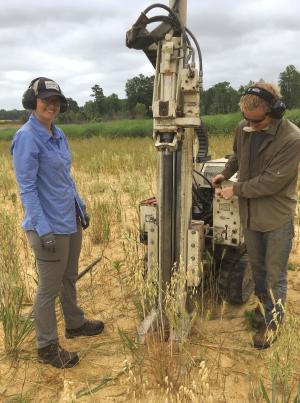Applying science and technology to improve national energy security, protect the environment, and understand and mitigate climate change
Laboratory researchers apply leading-edge capabilities to develop efficient and environmentally benign energy technologies and to investigate the processes behind climate change.
Insight into Carbon Storage
A Laboratory-led international team produced the first spatially resolved global estimates of mineral-associated carbon and the carbon-storage capacity of soil minerals. Soil is the largest terrestrial reservoir of organic carbon and is central to managing climate change and mitigation. The study found that regions under agricultural management and deeper soil layers contain the largest undersaturation of mineral-associated carbon. The degree of undersaturation can help inform sequestration efficiencies over years to decades. Another team including an LLNL researcher concluded that wildfires and prescribed burns may be an important nature-based climate solution to increase long-term soil organic carbon (SOC) storage. Carbon losses to the atmosphere due to fires are offset by reduced decomposition due to changes in the properties of organic materials in the soil.
In another study, research by LLNL scientists and collaborators found that rock weathering boosts SOC storage by altering soil mineralogy. As primary minerals in rocks weather to form soil, they create reactive, poorly crystalline minerals (PCMs) with less-than-perfectly-ordered structures that bind and store organic carbon. The team linked primary mineral weathering rates to the geographic distribution of PCMs across the United States and found that rock weathering enhances SOC storage at continental scales. However, the influence is limited because PCMs disappear over time as they ripen into more crystalline minerals. Additional active weathering of primary minerals is needed to maintain the amount of PCMs.
The Role of Microbes in the Carbon Cycle
Soil organic matter is the Earth’s largest carbon pool. Using new advances in DNA sequencing and isotope tracing, LLNL researchers discovered the importance of both living and dead microorganisms in forming SOC. Dead microorganisms accrete in soil as their cellular remains adhere to the mineral matrix. Their dead biomass can make up as much as 50 percent of the soil organic matter—translating to one of the largest stocks of organic carbon on the planet. Working with collaborators, another team developed a custom microscope using multiphoton nonlinear optics to image microbes in soil and plants at the micrometer scale with greater contrast and resolution. Yet another team created a porous microplate device for studying the exchange of nutrients and metabolites while blocking physical contact between adjacent microalgae cultures. Microscopic algae are responsible for half of the global atmospheric carbon fixed from the atmosphere through photosynthesis. The team found that the algal microscale environment is a complex ecosystem, which allows multiple microbial groups to thrive in different locations within it.
High-Resolution Modeling of Climate Change
Laboratory researchers have begun using DOE’s first exascale supercomputer to run version 2 of the Energy Exascale Earth System Model (E3SM) at 100-kilo-meter (km) resolution globally with a 25-km regionally refined grid over North America. Recently, an LLNL-led team created a variant version of E3SM—the Simple Cloud-Resolving E3SM Atmosphere Model (SCREAM). First implementation of this model is simplified and coarser than E3SM in many respects, with focus on improved representation of precipitation. SCREAM was run at 3.25-km resolution, 30 times finer than the typical resolution for climate modeling. The team performed a simulation corresponding to 40 days of Northern Hemisphere wintertime weather. SCREAM reproduced many features of Amazon basin precipitation much more realistically than E3SM and captured the frequency and structure of important weather events, such as cyclones, atmospheric rivers, and cold air outbreaks. The model leaves unresolved some existing climate model biases as compared to observation. The research team continues to refine SCREAM and has identified areas for further improvement.
Hydrogen Storage
Solid-state metal hydrides are attractive alternatives to gas-phase hydrogen storage because they provide excep-tional energy densities and can reversibly release and uptake hydrogen. However, many high-capacity metal hydrides require extreme hydrogen pressures to regenerate. For example, converting bulk metallic aluminum into alane (aluminum hydride), which has a volumetric hydrogen density twice that of liquid hydrogen, was long thought to be impossible except under more than 6,900 atmospheres of dihydrogen (H2) pressure. An LLNL–Sandia National Laboratories team found that alane situated within the nanopores of a highly porous framework can be regenerated at tenfold lower H2 pressure. Borides are also potential hydrogen-storage materials. LLNL researchers showed that metal boride surfaces and their single-layer variants can disorder dynamically from a regular arrangement of atoms at moderate temperatures. Dissociation of H2 is easier at some of the atomic sites, which in turn is expected to accelerate material activation during hydrogen storage.
Improvements in Lithium-Ion Batteries
Next generation lithium-ion (Li-ion) batteries will require higher energy and power densities at a lower cost. LLNL is partnering with Ampcera Inc. to develop solvent-free laser powder bed fusion methods to fabricate high-capacity 3D cathode structures that will enable faster charging, higher-energy-density Li-ion batteries. Solventless battery production would have higher throughput and lower energy consumption and cost. Another LLNL collaboration developed a powerful multiscale simulation capability to study the effect of microscale features, such as grain boundaries on ionic transport in solid electrolytes. The multiscale simulations will help overcome technical challenges to the design and development of Li-ion batteries with solid electrolytes, which have numerous intrinsic performance properties and safety advantages over conventional systems.







